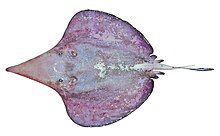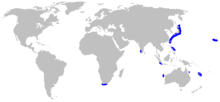Hexatrygonidae
| Sixgill stingray | |
|---|---|
 |
|
| Scientific classification | |
| Kingdom: | Animalia |
| Phylum: | Chordata |
| Class: | Chondrichthyes |
| Subclass: | Elasmobranchii |
| Order: | Myliobatiformes |
| Family: | Hexatrygonidae Heemstra & M. M. Smith, 1980 |
| Genus: |
Hexatrygon Heemstra & M. M. Smith, 1980 |
| Species: | H. bickelli |
| Binomial name | |
|
Hexatrygon bickelli Heemstra & M. M. Smith, 1980 |
|
 |
|
| Range of the sixgill stingray | |
| Synonyms | |
|
Hexatrematobatis longirostris Chu & Meng, 1981 |
|
Hexatrematobatis longirostris Chu & Meng, 1981
Hexatrygon brevirostra Shen, 1986
Hexatrygon taiwanensis Shen, 1986
Hexatrygon yangi Sheng & Liu, 1984
The sixgill stingray (Hexatrygon bickelli) is a species of stingray and the only extant member of the family Hexatrygonidae. Although several species of sixgill stingrays have been described historically, they may represent variations in a single, widespread species. This flabby, heavy-bodied fish, described only in 1980, is unique among rays in having six pairs of gill slits rather than five. Growing up to 1.7 m (5.6 ft) long, it has a rounded pectoral fin disc and a long, triangular, and flexible snout filled with a gelatinous substance. It is brownish above and white below, and lacks dermal denticles.
Benthic in nature, the sixgill stingray is usually found over upper continental slopes and seamounts at depths of 500–1,120 m (1,640–3,670 ft). It has been recorded from scattered locations in the Indo-Pacific from South Africa to Hawaii. This species probably uses its snout to probe for food in the bottom sediment. Its jaws are greatly protrusible, allowing it to capture buried prey. The sixgill stingray gives live birth, with litters of two to five pups. The IUCN has assessed this ray as Least Concern, because it faces minimal fishing pressure across most of its range.
The first known sixgill stingray, an intact female 64 cm (25 in) across, was found on a beach near Port Elizabeth, South Africa. It was described as a new species and placed in its own family by Phillip Heemstra and Margaret Smith, in a 1980 article for the Ichthyological Bulletin of the J. L. B. Smith Institute of Ichthyology. The generic name Hexatrygon is derived from the Greek hexa ("six") and trygon ("stingray"), referring to the number of gill slits. The specific name bickelli honors Dave Bickell, a journalist who discovered the original specimen.
...
Wikipedia

